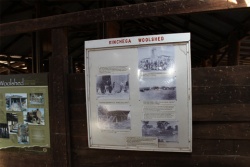IND/Kinship and Belonging
Traditional Aboriginal kinship systems are born of the Ancestors of the Dreaming and are amongst the most complex kinship systems in the world. They are based upon the concept of reciprocity and are all-embracing. They define an individual’s position within the immediate and extended family and the wider societal structure, and determine the rights, obligations and appropriate behaviours of kinship relations. In this way, kinship systems determine, amongst other things, who you can marry, who you must share food with, who you are to avoid, who you are allowed to joke with, who has responsibility to educate you, who you are to look after and who will look after you. The kinship system reinforces identity and ensures social cohesion and social control. They provide a deep sense of belonging, not only to other people and community but also to the land, the animals, plants, songs, rituals, art, stories and the Law as laid down in the Dreaming.
In other words, Indigenous Australian kinship systems are complex, not only in terms of their structure, but also because they encompass much more than people.
Within the discipline of anthropology, Indigenous kinship systems in Australia are known as classificatory systems of kinship. The classificatory system of kinship has two primary principles:
- Biological (genetically related), affinal (related by marriage) and classificatory kin (people or animals/totems that are considered related but who are not related biologically or through marriage) are considered the same.
- People of the same generation level who are the same sex are considered the same.
Each Indigenous group in Australia has its own variant of the classificatory system of kinship. Across Australia there are commonalities and differences, and, since the arrival of Europeans, there have been some changes due to the imposition of policies and practices, such as the Aborigines Protection Acts and Assimilation policy, and in response to a range of new circumstances. It is important to remember that all cultures change in some ways over time.
Some broad commonalities include:
- They are all-embracing; everyone belongs to the kinship system.
- The world, including people, plants, animals, waterways and celestial bodies, is divided into moieties (halves) or further divisions.
- A person has the same mutual obligations to people who are classificatory kin as they do to biological kin.
- There are people you can interact with, and people you cannot.
Today when Indigenous people meet, for many the first task is to determine where each person fits into the kinship system. Elders, especially women, hold the knowledge of family lines and relations. This knowledge has survived over two centuries of displacement and colonisation.
Who are Indigenous Australians?
The Aboriginal and Torres Strait Islander peoples of Australia traditionally define their identity according to their country or language nation, kinship and skin group and/or totemic association.
Today, Indigenous Australians are also identified according to the government definition of Indigeneity. The primary requirements under this definition are that a person must be:
- A descendant of an Indigenous Australian (Aboriginal or Torres Strait Islander)
- Identify as an Aboriginal or Torres Strait Islander person
- Be acknowledged by their community as an Indigenous person
Aboriginal and Torres Strait Islander peoples are also known as Indigenous Australians and acknowledged as being among the world’s indigenous peoples. Note that when we talk of Indigenous Australians we use a “capital I”, but when we talk of indigenous people around the world, we use a small “i”. Terminology used to refer to Indigenous people can be quite complex and words considered to be appropriate have changed over time.
Guidelines for Correct Terminology use in Aboriginal Studies
| Avoid | Use instead |
|---|---|
| aboriginal | Aboriginal |
| aboriginals/Aboriginals/aborigines | Aboriginal Australians/people/person etc |
| indigenous | Indigenous |
| The indigenous/the Indigenous | Aboriginal Australians/people/person etc |
| Them/they/those people | Indigenous or Aboriginal people/Australians |
| You people/you folk | Indigenous or Aboriginal people/Australians |
| Mixed blood, Half-caste, Quarter-caste, Full-blood, Part-Aboriginal, 25%/50% Aboriginal, Blacks, coloured, primitive | Aboriginal or Indigenous Australian/s |
| Tribe | Language group, nation, community or clan |
| Native | Indigenous or Aboriginal people/Australians |
You can/should also use the names which Aboriginal people use to refer to themselves:
| New South Wales, Victoria and Tasmania | Koori(e) |
| New South Wales and Queensland | Murrie |
| South Australia | Nunga |
| Western Australia | Nyungar |
| Central Australia | Anangu |
| Arnhem Land | Yolgnu |
Or if you know the language group of a person, you can use that, e.g. Wiradjuri.
